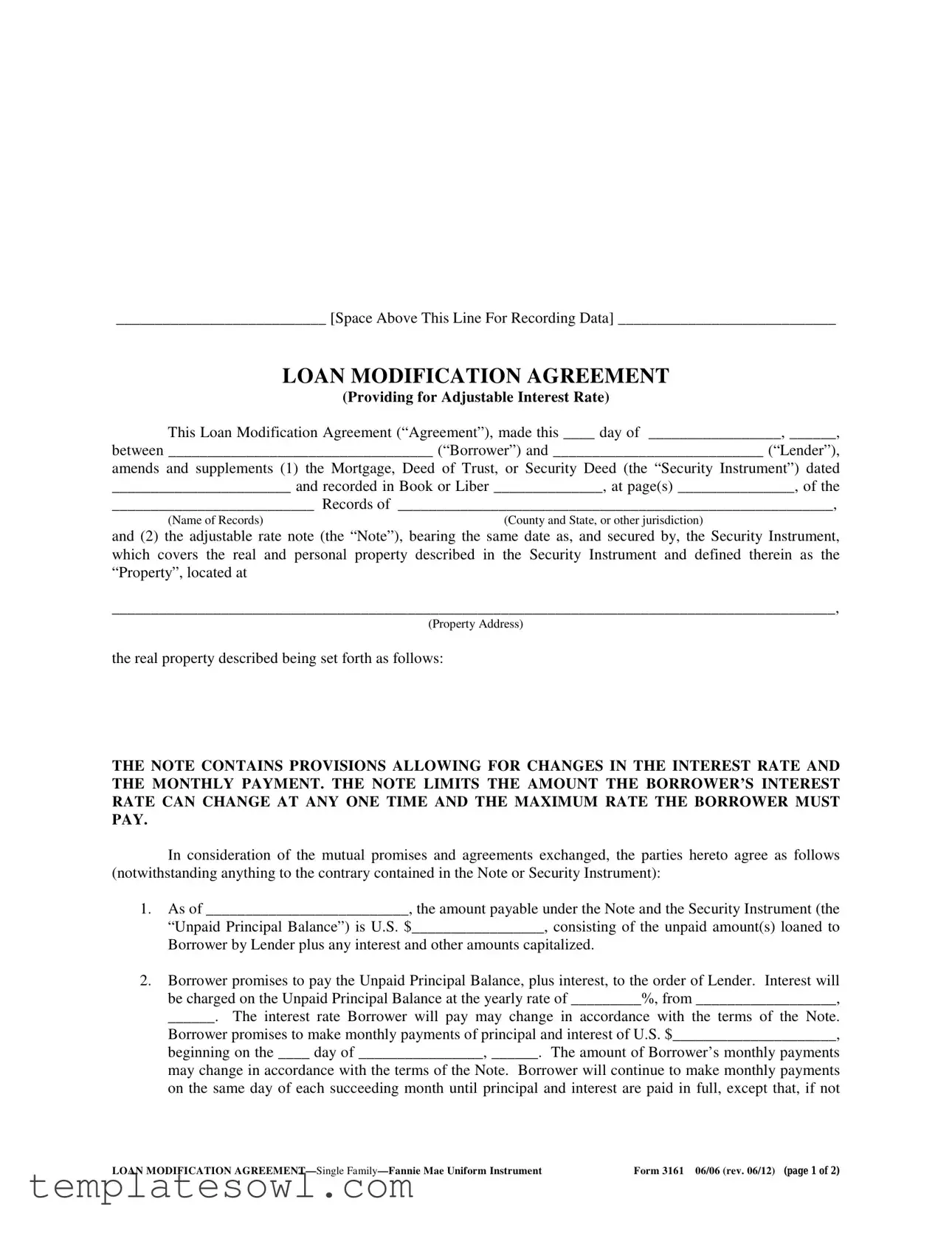___________________________ [Space Above This Line For Recording Data] ____________________________
LOAN MODIFICATION AGREEMENT
(Providing for Adjustable Interest Rate)
This Loan Modification Agreement (“Agreement”), made this ____ day of _________________, ______,
between __________________________________ (“Borrower”) and ___________________________ (“Lender”),
amends and supplements (1) the Mortgage, Deed of Trust, or Security Deed (the “Security Instrument”) dated
_______________________ and recorded in Book or Liber ______________, at page(s) _______________, of the
__________________________ Records of ________________________________________________________,
(Name of Records) |
(County and State, or other jurisdiction) |
and (2) the adjustable rate note (the “Note”), bearing the same date as, and secured by, the Security Instrument, which covers the real and personal property described in the Security Instrument and defined therein as the “Property”, located at
_____________________________________________________________________________________________,
(Property Address)
the real property described being set forth as follows:
THE NOTE CONTAINS PROVISIONS ALLOWING FOR CHANGES IN THE INTEREST RATE AND THE MONTHLY PAYMENT. THE NOTE LIMITS THE AMOUNT THE BORROWER’S INTEREST RATE CAN CHANGE AT ANY ONE TIME AND THE MAXIMUM RATE THE BORROWER MUST PAY.
In consideration of the mutual promises and agreements exchanged, the parties hereto agree as follows (notwithstanding anything to the contrary contained in the Note or Security Instrument):
1.As of __________________________, the amount payable under the Note and the Security Instrument (the “Unpaid Principal Balance”) is U.S. $_________________, consisting of the unpaid amount(s) loaned to Borrower by Lender plus any interest and other amounts capitalized.
2.Borrower promises to pay the Unpaid Principal Balance, plus interest, to the order of Lender. Interest will be charged on the Unpaid Principal Balance at the yearly rate of _________%, from __________________,
______. The interest rate Borrower will pay may change in accordance with the terms of the Note. Borrower promises to make monthly payments of principal and interest of U.S. $_____________________, beginning on the ____ day of ________________, ______. The amount of Borrower’s monthly payments may change in accordance with the terms of the Note. Borrower will continue to make monthly payments on the same day of each succeeding month until principal and interest are paid in full, except that, if not
LOAN MODIFICATION AGREEMENT—Single Family—Fannie Mae Uniform Instrument |
Form 3161 06/06 (rev. 06/12) (page 1 of 2) |
sooner paid, the final payment of principal and interest shall be due and payable on the ____ day of
________________, ______, which is the present or extended Maturity Date.
3.If on the Maturity Date, Borrower still owes amounts under the Note and the Security Instrument, as amended by this Agreement, Borrower will pay these amounts in full on the Maturity Date.
4.Borrower understands and agrees that
(a)All the rights and remedies, stipulations, and conditions contained in the Security Instrument relating to default in the making of payments under the Security Instrument shall also apply to default in the making of the modified payments hereunder.
(b)All covenants, agreements, stipulations, and conditions in the Note and Security Instrument shall be and remain in full force and effect, except as herein modified, and none of the Borrower’s obligations or liabilities under the Note and Security Instrument shall be diminished or released by any provisions hereof, nor shall this Agreement in any way impair, diminish, or affect any of Lender’s rights under or remedies on the Note and Security Instrument, whether such rights or remedies arise thereunder or by operation of law. Also, all rights of recourse to which Lender is presently entitled against any property or any other persons in any way obligated for, or liable on, the Note and Security Instrument are expressly reserved by Lender.
(c)Nothing in this Agreement shall be understood or construed to be a satisfaction or release in whole or in part of the Note and Security Instrument.
(d)All costs and expenses incurred by Lender in connection with this Agreement, including recording fees, title examination, and attorney’s fees, shall be paid by the Borrower and shall be secured by the Security Instrument, unless stipulated otherwise by Lender.
(e)Borrower agrees to make and execute such other documents or papers as may be necessary or required to effectuate the terms and conditions of this Agreement which, if approved and accepted by Lender, shall bind and inure to the heirs, executors, administrators, and assigns of the Borrower.
______________________________ (Seal) |
______________________________ (Seal) |
-Lender |
-Borrower |
By: ________________________________ |
______________________________ (Seal) |
|
-Borrower |
____________________________________ |
|
Date of Lender’s Signature |
|
___________________________ [Space Below This Line for Acknowledgements] __________________________
LOAN MODIFICATION AGREEMENT—Single Family—Fannie Mae Uniform Instrument |
Form 3161 06/06 (rev. 06/12) (page 2 of 2) |
